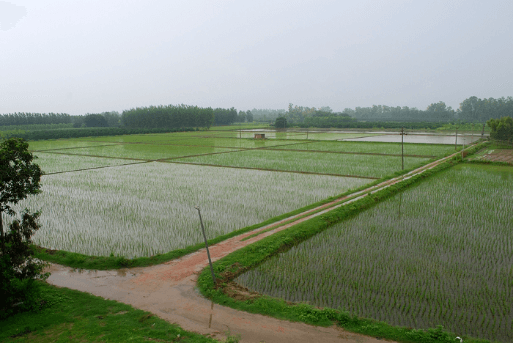Green Revolution Definition
The Green Revolution is the process of enhancing agricultural output using modern methods and instruments. Agriculture output is linked to the Green Revolution. Around this time, the nation's agriculture was transformed into an industrial system by adopting modern agricultural methods such as high-yielding seed types, tractors, irrigation, pesticides, & fertilizers.

The three main components of the Green Revolution's methods were:
High-yield Crop varieties- Scientists created new crop types with higher yields than conventional crops. These plants were developed to have shorter growing seasons and to be disease- and drought-tolerant.
Irrigation- Farmers employed irrigation systems to ensure that crops received sufficient water throughout the growing period to support the higher yields of the crops. There are several different types of irrigation systems, from straightforward ones like flood irrigation to more intricate ones like drip irrigation.
Fertilizers and Pesticides- Farmers use synthetic fertilizers and insecticides to boost agricultural yields and safeguard crops against disease and pests. These inputs were applied selectively to ensure that the crops received the nutrients they needed while minimizing the environmental impact of the excessive application.
Mechanization- Using machinery and technology to boost farm production and efficiency was a part of the Green Revolution. Tractors and other equipment, for instance, were utilized to expedite planting, harvesting, reaping, and other processes.
Agriculture extension services- To inform farmers about the newest methods and technology and offer help and advice on using them successfully, governments and other organizations offer extension services.
Schemes Under Green Revolution (India)
In India, some of the major programs that were introduced as a part of the Revolution include:
- The High-Yielding Varieties Programme (HYVP) - Was established in 1966 to raise agricultural output by introducing high-yielding seed types. Wheat, rice, & maize were the main crops discussed in the program.
- Intensive Agricultural Development Programme (IADP)- This initiative was started in 1960-1961 to boost agricultural output by adopting improved farm management methods, better irrigation infrastructure, and encouraging the use of fertilizers and pesticides.
- The National Seeds Corporation (NSC)- This was formed in 1963 to create and offer farmers high-quality seeds at competitive costs.
- Small Farmer Development Agency (SFDA)- This was established in 1974 to assist marginal and small-scale farmers by enhancing their access to loans, technology, and other inputs.
- Rashtriya Krishi Vikas Yojana (RKVY)- This initiative started in 2007 and aims to boost agricultural production and support sustainable agriculture. The program offers governments financial support for various agricultural activities such as research, outreach, or infrastructure building.
- The National Food Security Mission (NFSM)- This was established in 2007 to boost food production and decrease food insecurity. The plan's main objective is to increase the cultivation of rice, wheat, & pulses in selected national districts.
- Pradhan Mantri Fasal Bima Yojana (PMFBY)- This was introduced in 2016 to offer farmers crop insurance against agricultural losses brought on by pests, diseases, and natural disasters.

Features
- With assistance from the US and other foreign organizations, the Indian government started the Green Revolution.
- M.S. Swaminathan, an agricultural scientist from India, led the program and collaborated with the Ford and Rockefeller foundations to create high-yield wheat and rice cultivars.
- The Green Revolution aimed to boost agricultural production and productivity by utilizing cutting-edge technology, including high-yielding seed types, fertilizers, and insecticides.
- Crop yields increased significantly due to the Green Revolution, especially for rice and wheat.
- The Green Revolution's new technology contributed to a rise in the productivity of India's agricultural industry.
- The Green Revolution also influenced infrastructure and irrigation system development in rural regions.
- India's food security and poverty levels were improved because of the Green Revolution's higher production and output.
- Increased agricultural productivity helped India's economy develop overall, which was a result of the Green Revolution.
- The Green Revolution helped many farmers boost their income via higher production, which also aided in the expansion of India's middle class.
- Due to the Green Revolution, India's agricultural growth has benefited greatly from establishing agro-research institutions.
- Many farmers in India still employ the innovations made during the Green Revolution, which has had a lasting impact on the country's agricultural industry.
Drawbacks of the Green Revolution
The Green Revolution increased agricultural productivity significantly, but it also had several adverse consequences, including some of the following:
- Environmental issues- The Green Revolution mainly relied on chemical pesticides, fertilizers, and irrigation systems, all of which had detrimental environmental effects. Groundwater supplies were depleted due to excessive chemical pesticides and fertilizers, which contaminated the soil and water.
- Increased social inequality- Farmers with the latest technology and those who did not experience increased economic disparity due to the Green Revolution. Farmers who could pay for the latest technology had considerable production gains, while others couldn't be kept up with the competition.
- Degradation of the soil- The extensive use of chemical pesticides and fertilizers stripped the soil of its organic fertility, leaving it vulnerable to toxic substances. This resulted in soil deterioration, an ongoing issue that reduces land production and calls for costly remediation.
- Groundwater depletion- The Green Revolution encouraged the consumption of groundwater for agricultural purposes, which has contributed to aquifer depletion and a reduction in groundwater levels, particularly in areas with little rainfall.
- Soil erosion- Using large equipment to plow and the plant has resulted in soil erosion and compaction, which has decreased soil fertility and production over time.
- Dependency on outside inputs- Due to the Green Revolution's heavy reliance on external supplies like fertilizers, herbicides, and high-yield seeds, farmers are now dependent on outside vendors and are more susceptible to price changes.
- Reduction in crop diversity- The concentration on high-yield crops has reduced crop variety, making the agricultural sector more susceptible to pests and diseases.
- Negative health impact- Heavy pesticide usage has had a detrimental effect on farmers' and farmworkers' health, increasing the prevalence of illnesses, including cancer, respiratory problems, and skin conditions.
- Unsustainable resource use- The Green Revolution has resulted in the unsustainable utilization of resources, including soil, water, and fossil fuels, which has caused their depletion and environmental deterioration.
- Dependency on fossil fuels- The Green Revolution's use of equipment necessitates using fossil fuels that contribute to climate change and greenhouse gas emissions.
- Genetic variety loss- The Green Revolution concentrated on a small amount of productive agricultural types, which made crops more susceptible to disease & pests.
- Water depletion- The Green Revolution has increased water usage for irrigation, resulting in certain places experiencing water depletion.
- Debt- Farmers have often been forced to make substantial financial investments to embrace new technology and inputs during the Green Revolution.
- Food insecurity- The Green Revolution hasn't necessarily resulted in enhanced food security for everybody since it has mostly concentrated on producing cash crops for export instead of food for local use.
- Erosion of traditional farming- Traditional farming knowledge and practices have been lost due to the Green Revolution's emphasis on contemporary farming techniques.
- Landlessness- Due to the Green Revolution, a few large-scale farmers now control a disproportionate amount of the world's land, leaving many small farmers without access to it and living in poverty.
- Cultural diversity loss- The extinction of traditional agricultural methods and expertise can also result in losing identity and cultural variety.
- Loss in biodiversity- Farmers have given up traditional crop types and animal breeds due to the emphasis on high-yielding agricultural varieties.
The Conclusion
The Green Revolution, which started in the middle of the 20th century, featured the creation and acceptance of high-yielding crop types, increasing use of pesticides and fertilizers, and contemporary agricultural methods. Its goal was to boost food production and reduce hunger in underdeveloped nations. Even while agricultural yields were successfully increased, there were detrimental consequences for the environment and local farmers. Therefore, the Green Revolution is still contentious and complicated with good and bad effects.
|


 For Videos Join Our Youtube Channel: Join Now
For Videos Join Our Youtube Channel: Join Now










